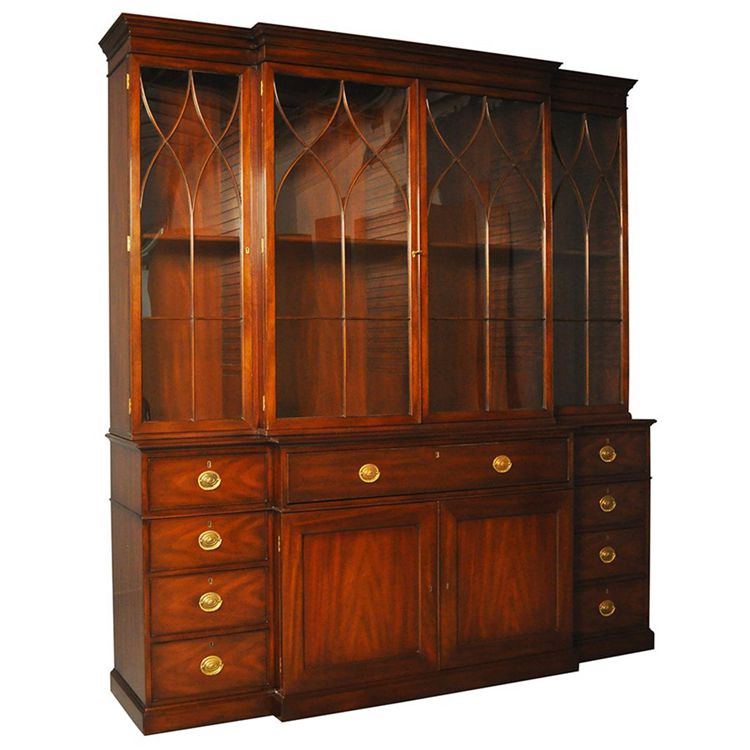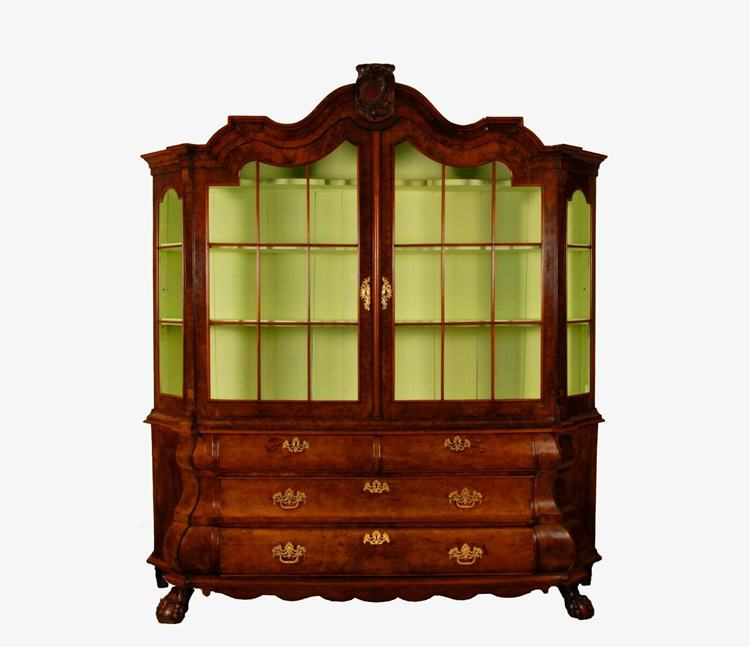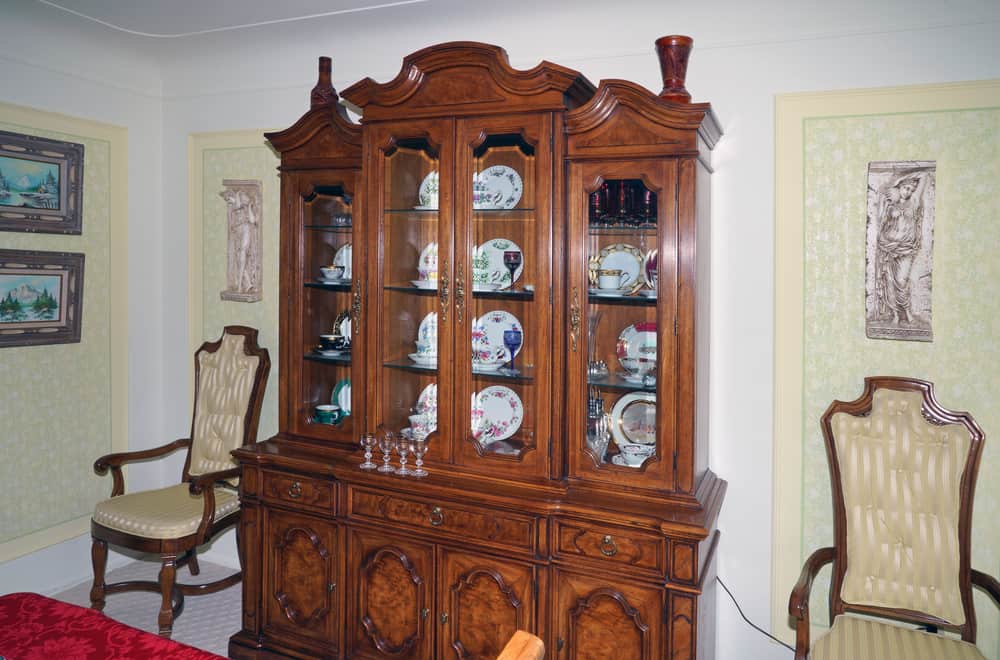Factors Influencing Value

The value of an antique china cabinet is determined by a combination of factors, each contributing to its overall worth. Understanding these factors can help you determine the potential value of your own china cabinet.
Age
The age of a china cabinet is a crucial factor in determining its value. Older cabinets, especially those from the 18th or 19th centuries, are often more valuable due to their historical significance and rarity. The age of a cabinet can be determined through various methods, including examining its construction techniques, style, and any markings or labels. For example, a Victorian-era china cabinet from the late 19th century could fetch a higher price than a similar cabinet from the early 20th century.
Maker and Manufacturer, How much is an antique china cabinet worth
The maker or manufacturer of a china cabinet can significantly impact its value. Certain makers and manufacturers are known for their high-quality craftsmanship, unique designs, and historical significance. Cabinets made by renowned furniture makers, such as Chippendale, Hepplewhite, or Sheraton, are highly sought after by collectors and can command significant prices. For instance, a china cabinet made by Thomas Chippendale, a famous 18th-century English furniture maker, could be worth significantly more than a similar cabinet made by an unknown maker.
Materials
The materials used in the construction of a china cabinet play a significant role in determining its value. High-quality woods, such as mahogany, walnut, or cherry, are more desirable than cheaper woods like pine or oak. The quality of the wood, its condition, and the craftsmanship used in its construction all contribute to the cabinet’s value. For example, a china cabinet made from solid mahogany with intricate hand-carved details would be more valuable than one made from oak with a simple finish.
Decorative Elements
Decorative elements, such as carvings, inlays, and hardware, can enhance the value of an antique china cabinet. Intricate carvings, ornate inlays, and high-quality hardware can add to the cabinet’s aesthetic appeal and increase its value. For instance, a china cabinet with hand-carved floral motifs and brass hardware would be more valuable than one with simple carvings and plain hardware.
Condition
The condition of a china cabinet is another important factor in determining its value. Cabinets in excellent condition, with minimal wear and tear, are more valuable than those that have been damaged or restored. However, restoration can sometimes increase the value of a china cabinet if it is done professionally and ethically. For example, a china cabinet that has been professionally restored to its original condition might be worth more than a similar cabinet that has been poorly restored or left in a neglected state.
Determining Market Value

To determine the market value of your antique china cabinet, you need to understand the factors influencing its worth and then research comparable pieces. This involves a combination of online research, expert appraisals, and understanding the typical price ranges for different antique china cabinets.
Researching Comparable Antique China Cabinets
Finding comparable pieces is crucial to establish a reasonable price range for your antique china cabinet. You can do this by researching online marketplaces and auction records.
- Online Marketplaces: Websites like eBay, Etsy, and LiveAuctioneers offer a vast database of antique furniture for sale. You can filter your search by s like “antique china cabinet,” “vintage china cabinet,” or the maker’s name. This allows you to compare prices and see what similar cabinets have sold for in recent times.
- Auction Records: Auction houses like Sotheby’s, Christie’s, and smaller regional auction houses often publish online catalogs or databases of past sales. These records can provide valuable insights into the prices achieved for similar antique china cabinets. Look for details like the maker, age, condition, and selling price.
Expert Appraisals
Expert appraisals can provide a more accurate assessment of your antique china cabinet’s value. A qualified appraiser will examine the cabinet, consider its maker, age, condition, and historical significance, and then provide a written report outlining its fair market value.
Typical Price Ranges for Antique China Cabinets
The price range for antique china cabinets varies greatly depending on age, maker, condition, and style. Here’s a table illustrating typical price ranges:
| Age | Maker | Condition | Price Range |
|---|---|---|---|
| 18th Century | Chippendale | Excellent | $10,000 – $50,000+ |
| 19th Century | Victorian | Good | $1,000 – $10,000 |
| Early 20th Century | Art Deco | Fair | $500 – $5,000 |
Resources and Websites for Antique Furniture Valuation
Several online resources and websites specialize in antique furniture valuation. These websites can provide valuable information on antique furniture history, identification, and price guides.
- Antiques Roadshow: This popular PBS show features expert appraisers who provide valuations for a wide range of antiques, including furniture.
- Kovels: This website offers a comprehensive database of antique furniture prices, maker information, and identification guides.
- The Antique Trader Price Guide: This guide provides detailed price information for a variety of antiques, including furniture.
Tips for Selling an Antique China Cabinet: How Much Is An Antique China Cabinet Worth

Selling an antique china cabinet can be a rewarding experience, especially if you know how to prepare it for sale and market it effectively. From cleaning and restoration to choosing the right sales channel, a little effort can make a big difference in the final price you receive.
Preparing for Sale
Proper preparation is key to maximizing the value of your antique china cabinet.
- Thorough Cleaning: A deep clean is essential to remove dust, grime, and any signs of wear. Use a soft cloth and mild soap to clean the cabinet’s exterior and interior. Pay special attention to intricate details and carvings, gently cleaning them with a small brush. Avoid harsh chemicals or abrasive cleaners that could damage the finish.
- Restoration: Depending on the cabinet’s condition, you might consider restoration to enhance its value. Minor repairs like replacing missing hardware or fixing loose joints can significantly improve its appeal. However, for major restorations, it’s wise to consult with a professional to avoid damaging the piece.
- Polishing: A polished finish can significantly enhance the appearance of an antique china cabinet. Use a furniture polish designed for antique finishes, applying it in thin coats and buffing it to a shine. Avoid using too much polish, as it can leave a sticky residue or create a cloudy appearance.
Choosing the Right Sales Channel
The right sales channel can make a significant difference in reaching the right buyers and maximizing your profit.
- Online Auctions: Platforms like eBay and Etsy offer a wide reach and can attract buyers from all over the world. You can set a starting price and let buyers bid on your cabinet, potentially driving up the price. However, online auctions involve fees and shipping costs, which can eat into your profits.
- Antique Stores: Consignment shops specialize in selling antique furniture and can provide expert advice on pricing and marketing. They handle the logistics of sales, but they also take a commission on the sale price.
- Estate Sales: If you’re selling multiple items, an estate sale can be a convenient and cost-effective option. However, estate sales typically attract buyers looking for bargains, so you may not get the full market value for your cabinet.
Setting a Competitive Asking Price
Setting the right asking price is crucial to attracting buyers and maximizing your profit.
- Research Comparable Sales: Check online auction sites, antique dealer websites, and recent estate sale listings to get an idea of the current market value for similar china cabinets. Consider factors like age, style, condition, and materials.
- Consider Location: Prices for antiques can vary significantly depending on your location. If you’re in a major metropolitan area with a strong antique market, you may be able to command a higher price.
- Factor in Costs: Don’t forget to factor in any restoration costs, shipping fees, and any applicable sales taxes when setting your asking price.
Marketing and Advertising
Effective marketing and advertising can attract the right buyers and increase your chances of a successful sale.
- High-Quality Photos: Take clear, well-lit photos that showcase the cabinet’s features and condition. Use a tripod and natural light for the best results. Consider taking photos from different angles and highlighting any unique details or craftsmanship.
- Detailed Description: Provide a comprehensive description that includes the cabinet’s age, style, materials, dimensions, and any notable features. Highlight any unique details or craftsmanship and mention any restoration work done.
- Targeted Advertising: Target your ads to potential buyers by using relevant s and phrases in your online listings and social media posts. Consider advertising on antique websites, social media groups, and local publications.
How much is an antique china cabinet worth – The value of an antique china cabinet depends on various factors, including its age, maker, condition, and style. While many antique cabinets are crafted from solid wood, some feature glass doors for showcasing treasured china, much like an oak cabinet with glass doors might display decorative items.
However, the intricate details, historical significance, and potential provenance of an antique china cabinet can significantly impact its worth.
The value of an antique china cabinet can vary greatly depending on its age, maker, condition, and style. While antique pieces often command high prices, modern interpretations like contemporary curio cabinets glass offer a stylish and functional alternative for displaying treasured items.
Determining the worth of an antique china cabinet requires a professional appraisal, taking into account its unique characteristics and historical significance.
